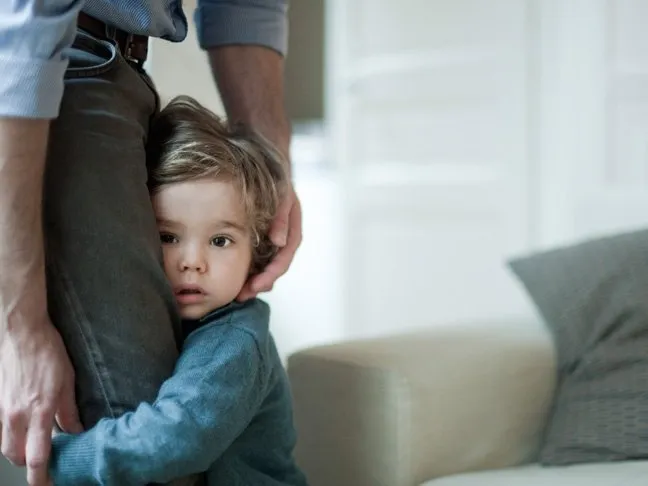I will never forget the first time I left my daughter with a new caregiver. She was just about 6-months-old. During those first six months she spent quite a bit of time with grandparents, and my husband and I shifted our schedules around so that I could get back to my private practice without hiring full-time help. By six months, we needed the help.
I dutifully interviewed a number of potential nannies, called references, and introduced my daughter to them. She smiled at every last one of them and seemed ready to enjoy time with a nanny a few afternoons a week. That very first day, however, something shifted. She trembled. She whimpered. She screamed and cried. This lovely nanny who sang to her and rocked her and cuddled her tried everything to soothe her, but there was no soothing. She seemed to understand that this new friendly face meant mine would disappear, and she wasn’t pleased.
Stranger anxiety is a normal part of cognitive development, and it tends to happen alongside separation anxiety. For the first six months of life, many babies are content around, and even interested in, other adults. Somewhere between 6 to 9 months of age, however, babies begin to differentiate their parents and caregivers from other adults. They also understand that their parents might leave the room, which feels like a disappearance in the mind of an infant.
Most babies outgrow stranger anxiety after the first year, but temperament does play a role in how young children interact with strangers. It’s also fairly common for toddlers, preschoolers, and even early elementary age children to exhibit anxious behavior when encountering strangers.
Infancy
Infants tend to react immediately with tears and protests when unfamiliar people approach them or attempt to pick them up. They become visibly upset, and this can actually be distressing for relatives and friends who only want to engage with the baby. When unfamiliar adults approach slowly with a parent nearby and use a calm, quiet voice, some babies will maintain interest and avoid distress.
At this age, it’s important to show your baby that other adults are safe and comforting and that you will return.
1. Smile when a relative or babysitter holds your baby. This helps to communicate to your baby that the person holding her is a safe, friendly person.
2. Ask the babysitter to arrive early, so that your baby has time to warm up to the sitter’s presence before you need to leave.
3. Make your departure quick, but don’t sneak out. A quick kiss and goodbye is all you need.
Toddlers and preschoolers
Stranger anxiety is often coupled with separation anxiety and transitions during this time. Toddlers and preschoolers understand that when parents leave, they will be with someone else. They might even be left with a new teacher in a new environment for several hours. They know enough to feel anxious about the changes taking place and the departure of mom or dad.
While stranger anxiety often arises for toddlers and preschoolers with the transition to school or daycare, it can also occur gradually with people they spend a lot of time with, like grandparents or aunts and uncles. Rest easy, this is still a very normal part of child development and you didn’t do anything to make this happen. Some children experience intense stranger anxiety while others don’t experience it at all. During this period, your child may tend to hide behind you, cling to your leg, refuse to greet other adults, or cry when being left with a nanny or relative.
1. Provide reassurance when your child feels anxious. A little empathy goes a long way toward helping toddlers and preschoolers feel safe and comforted.
2. Clue the relatives in. If your child is struggling to engage with other adults, even familiar ones, be honest with the people around her. Encourage them to get down to your child’s level and engage in play when you are present to ease the transition.
3. Stick around to ease the transition when you leave your child with a relative or other caregiver. You don’t want to hang around too long, because you don’t want to model lack of comfort, but it’s a good idea to spend five to ten minutes getting your child settled with a favorite toy, book, or puzzle before you say goodbye.
4. Model positive communication with other adults. When your young child sees you excited to see someone, he will internalize the message that this is a great person to know.
5. Prepare for transitions and keep your promises. Tell your child what’s happening. Example: You get to play at Grandma’s for two whole hours! We’ll pack your favorite snacks and a few toys to play with Grandma. Mommy will be back at lunchtime. Return when you say you will. Being late once or twice is no big deal, but chronic lateness can hinder your child’s ability to trust you.
School age
School age children receive some very mixed messages about strangers. On the one hand, they are consistently told to be cautious around strangers. On the other hand, they are forced to hug great uncle Joe once a year. It’s confusing, at best, and leads to insecurity and worries. Many school age children freeze up or put their heads down and remain quiet when meeting unfamiliar adults because they aren’t sure what to do.
1. Model friendliness out in the world. Greet people often. When parents model friendliness to strangers out in the community, kids learn that most strangers are actually nice and it’s kind to greet people.
2. Offer to help a neighbor in need whenever possible. Acting as a community helper strengthens bonds between neighbors and builds a stronger sense of community. It also shows kids that our neighbors look out for us, just as we look out for them.
3. Practice greetings and goodbyes at home Teach your kids how to meet someone new so they don’t freeze up and feel afraid in the presence of strangers.
4. Talk about good strangers (helpers) versus strangers kids should avoid. Say something along the lines of: “Most strangers are actually kind people that we just don’t know yet. Police officers, parents of other kids at the park, fire fighters, librarians, people working at stores, and nurses and doctors are all strangers who can help us out if we need something. They usually smile and say hello. Strangers should never offer to give you a ride somewhere, give you food, pick you up from school or sports practice, or tell you that you can go with them because they know me or Daddy.”
I often find myself reminding my own kids that strangers are just friends we haven’t met yet. While it’s important to teach kids to say no if a stranger offers a ride, food, or something else enticing, we also need to teach them that there are great people in the world. The best way to work through stranger anxiety is to help kids learn to connect to new people. They will learn best by watching you.
Photo: Getty








